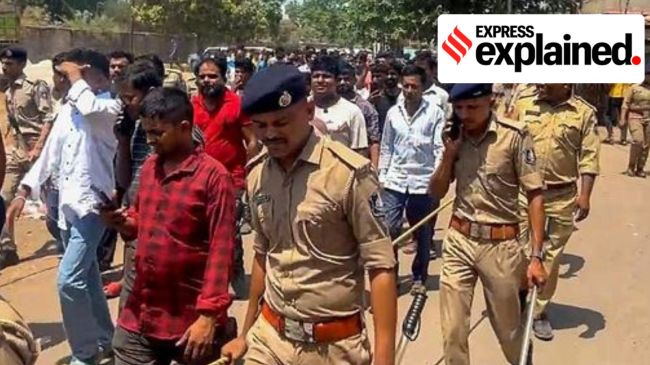Opinion How latest drive to deport illegal Bangladeshi immigrants stands out
Since Operation Sindoor, India has stepped up its efforts to deport illegal Bangladeshi immigrants in a drive that stands out due to its urgency and scale
 As more people are rounded up and transported to the borders, courts and civil rights groups are likely to scrutinise the legal and ethical contours of this drive, especially in cases involving pending litigation or individuals caught in border limbo.
As more people are rounded up and transported to the borders, courts and civil rights groups are likely to scrutinise the legal and ethical contours of this drive, especially in cases involving pending litigation or individuals caught in border limbo. Since Operation Sindoor was launched on May 7, Indian authorities have “pushed back” more than 2,500 allegedly illegal Bangladeshi immigrants across the international border.
 What distinguishes this drive is the urgency and scale: the government has not only issued a 30-day deadline for verification of illegal immigrants, but identified individuals are now being transported in Indian Air Force aircraft from various states to border outposts.
What distinguishes this drive is the urgency and scale: the government has not only issued a 30-day deadline for verification of illegal immigrants, but identified individuals are now being transported in Indian Air Force aircraft from various states to border outposts.This has, however, raised concerns around due process, humanitarian issues, and pending litigation, especially reports of people being left in the no man’s land between India and Bangladesh.
First, some historical context
Migration between what is now Bangladesh and India dates back to British times.
* The colonial administration encouraged settlement in the then sparsely populated Assam by bringing in labourers from Bengal and North India.
* Post-Partition, millions of refugees from East Pakistan, mostly Hindus, moved to India. Amid the brutal Pakistani crackdown on Bengalis, some 10 million people, mostly Hindus, sought refuge in India in 1971 alone.
* Over the decades, economic migration from Bangladesh to India has continued, with many crossing the border into states like Assam and West Bengal in search of jobs.
This influx has led to significant socio-political tension, particularly in Assam. While the India-Bangladesh border is largely fenced today, gaps remain, and illegal migration persists, with Bangladeshi workers visible in metropolitan labour markets across India.
There is presently no official or universally accepted figure about the number of illegal Bangladeshi immigrants in India, and estimates have varied widely.
In 2004, then MoS (Home) Sriprakash Jaiswal told Parliament that 12 million illegal Bangladeshi immigrants resided in India. (This claim was withdrawn following protests by the Assam and West Bengal governments.)
Former RAW chief Sanjeev Tripathi, in a 2016 paper, estimated the number to be more than 15 million, based on comparisons of census data from Bangladesh and India from 1981 to 2011. The same year, MoS (Home) Kiren Rijiju told Parliament that 20 million illegal Bangladeshi immigrants were living in India, based on unofficial assessments.
Deportations pick up under BJP
The deportation of illegal immigrants has been an enduring part of India’s domestic policy, cutting across political lines. The UPA government too deported illegal Bangladeshi immigrants. RPN Singh, who served as MoS (Home) from 2012 to 2014, claimed in 2018 that the Manmohan Singh government had deported 82,000 immigrants.
These efforts have further picked up under the Narendra Modi government, driven by both national security concerns and ideological motivations. In 2018, then-BJP president and current Union Home Minister Amit Shah had referred to Bangladeshi immigrants as “termites”.
Since 2018, the Modi government has also pursued a more tech-driven approach to the problem.
* That year, it launched the identification.mha.gov.in portal to collect the biographic and biometric data of Rohingya immigrants. This was later expanded to include Bangladeshi immigrants as well.
* In 2023, the government revamped this portal into the Foreigners Identification Portal (FIP) to capture more detailed profiles of suspected illegal immigrants.
States/UTs and the Ministry of External Affairs were given access to the portal, which is used to upload and verify details of suspected illegal immigrants. If verification fails, deportation is initiated with help from the Foreigners’ Regional Registration Offices (FRROs).
* In 2023, the government also introduced a District Police Module on the Immigration Visa Foreigner Registration Tracking (IVFRT) portal to track overstaying foreigners.
* Further, biometric capture infrastructure — fingerprint scanners, cameras, and computers — has been deployed across police stations, detention centres, and Border Out Posts (BOPs) of the BSF.
A renewed push, novel strategy
While the issue was never truly on the back burner, deportation drives have intensified following the terror attack in Pahalgam on April 22, and the beginning of Operation Sindoor on May 7.
Currently, states such as Gujarat, Delhi, Assam, Maharashtra, and Rajasthan are rounding up identified illegal immigrants and transporting them to border points in Assam, Tripura, and Meghalaya. From here, they are “pushed back” across the border by the Border Security Force (BSF).
A senior security official told The Indian Express that such deportations have historically had limited success. “The border is porous. These people often return,” he said.
However, the current operation marks a more coordinated, digitised approach to the problem of illegal migration. With biometric data now captured on the FIP, the government hopes re-entry can be checked.
The Ministry of Home Affairs (MHA) has also instructed authorities issuing Aadhaar, Voter ID, and Ration Card to cross-check applicants against the immigrant database before issuing documents.
The MHA has set a 30-day deadline for States and UTs to verify suspected illegal immigrants from Bangladesh and Myanmar. If verification fails, deportation proceedings will follow. An integrated server will support this process, bringing together data from the IVFRT system, the FIP portal, and the India-Myanmar Border Pass System.
Some questions remain
Questions around due process, humanitarian concerns, and bilateral sensitivities persist.
As more people are rounded up and transported to the borders, courts and civil rights groups are likely to scrutinise the legal and ethical contours of this drive, especially in cases involving pending litigation or individuals caught in border limbo.
On May 8, Bangladesh sent a diplomatic note to India registering its protest over the issue. Country’s Foreign Affairs Adviser Md Touhid Hossain said on Tuesday that another such note was in the works. “We see it (deportation) is happening. It is not feasible to resist physically,” he said, stressing the need for diplomatic and legal processes to be followed in resolving consular issues.
The issue has always been diplomatically sensitive. In a 2022 BSF-BGB meeting in Dhaka, the Border Guard Bangladesh (BGB) reportedly told India that illegal immigration from Bangladesh has reduced, largely due to economic improvements.
At one point in 2020-21, Bangladesh’s per capita income ($1,962) was higher than India’s ($1,935) — a data point that complicates the narrative of large-scale economic migration.







